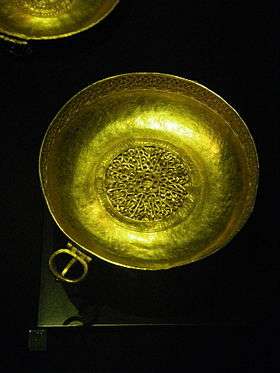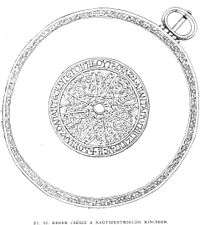Buyla inscription
| The Buyla Inscription | |
|---|---|
 The buckled bowl bearing the Buyla inscription. | |
| Material | gold |
| Created | Middle or Late Avar Period (670 AD – 800 AD) |
| Discovered | 1799 near Nagyszentmiklós (today Sânnicolau Mare in Timiş County, Romania) |
| Present location | Kunsthistorisches Museum, Vienna |
The Buyla inscription is a 9-word, 56-character inscription written in the Greek alphabet but in a non-Greek language. It is found on a golden buckled bowl or cup which is among the pieces of the Treasure of Nagyszentmiklós[1][2] which are now in the Kunsthistorisches Museum in Vienna.[1][3] The bowl is 12 cm in diameter and weighs 212 g, and has a handle or buckle, perhaps for hanging on a belt. The inscription is found around the outside of a circular design in the middle of the bowl. In the place where the inscription begins and ends, there is a cross. The inscription reads: ΒΟΥΗΛΑ·ΖΟΑΠΑΝ·ΤΕϹΗ·ΔΥΓΕΤΟΙΓΗ·ΒΟΥΤΑΟΥΛ·ΖΩΑΠΑΝ·ΤΑΓΡΟΓΗ·ΗΤΖΙΓΗ·ΤΑΙϹΗ.[4]
Prevailing opinion is that the language of the text is a Turkic language, and several translations have been proposed, though none are agreed upon.[1][5][2] Vilhelm Thomsen translated the inscription: "Boila zoapan finished this bowl [this drinking cup], which Boutaoul zoapan made suitable for hanging up."[6] Nikola Mavrodinov translated it: "Bouila zoapan made this cup; Boutaul Zoapan made this cup suitable for drinking from."[6] Gyula Németh translated it: "Boila chaban's bowl, which was made to his order; Boutaoul had a buckle made for it, and this is his bowl."[6] Paul Lazăr Tonciulescu translated it: "Jupan Buila [has] all rights, jupan Butaul [has the right of] entering [in] all towns.[7]
Description
The treasure of Nagyszentmiklós
The treasure of Nagyszentmiklós, of which the bowl is a part, consists of 23 decorated gold vessels weighing around 10 kg.[8][9][3] It was found in 1799 on the banks of the Aranca river, near Nagyszentmiklós (today Sânnicolau Mare in Timiş County, Romania),[10][3][11] in the region of Avar settlement in the Carpathian Basin.[12] It was also attributed to the lower Danube Bulgars,[13] but the current view is that the treasure is of Avar origin and closely related to the Avar culture.[14][12][13][15]
The objects were made by specialized craftsmen in the 7th and 8th centuries[14][16][12] and were hoarded by local lords.[17][18] The treasure was last "used" and buried in the second half of the 8th century or perhaps in the early 9th century.[12][18]
Some of the vessels bear runiform inscriptions. Similar characters can be found on a bone needle case excavated in the Late Avar cemetery of Szarvas (in Békés County, Hungary) and dated to the second half of the 8th century.[8][19] Based on this evidence, some scholars proposed a similar date for the Nagyszentmiklós inscriptions.[8][11]
The inscription

The Buyla inscription is engraved in Greek letters on the inner bottom of a round buckled bowl (no. 21 in József Hampel's list), on a flat ring surrounding a lavishly decorated disk.[20][21]
The inscription has the following text, easily readable, and uses a 'C'-shaped glyph for sigma:[22][23][21]
- † ΒΟΥΗΛΑ • ΖΟΑΠΑΝ • ΤΕϹΗ • ΔΥΓΕΤΟΙΓΗ • ΒΟΥΤΑΟΥΛ • ΖΩΑΠΑΝ • ΤΑΓΡΟΓΗ • ΗΤΖΙΓΗ • ΤΑΙϹΗ
The lower case equivalent is:
- † βουηλα • ζοαπαν • τεση • δυγετοιγη • βουταουλ • ζωαπαν • ταγρογη • ητζιγη • ταιση
The transliteration is:
- † bouēla • zoapan • tesē • dugetoigē • boutaoul • zōapan • tagrogē • ētzigē • taisē
Paleographic and epigraphic considerations
Some of the letters of the inscription have distinctive shapes. The letters sigma and epsilon have broad arcs.[24] The base line of delta juts out on both sides.[25] Beta has also a prominent base line, a form found in the Greek inscriptions from Bulgaria dated to the early 9th century,[24][26][27] but otherwise it is rarely attested in the Greek-writing world: only[24][26] on several Cherson coins of the Byzantine emperor Basil I (867-886)[26][27][28] and also on one inscription of the same emperor, found in Mesembria (today Nesebar, Bulgaria).[26][29] The shape of alpha is also attested on the 9th century Greek inscriptions from Bulgaria.[24] On the other hand, omega's unusual shape, with a middle vertical line higher than the rounded sides, is specific for the 6th century Greek inscriptions and the oldest forms of the Greek Uncial script.[24][30]
Vowels
In this inscription there is a free alternation between ε and αι, η and ι, and ο and ω.[31][32] These groups became homophones in Koine Greek, merging to /ɛ/, /i/ and /o/.[31][33] Also ου was read /u/,[33] υ was read /y/,[34][32][33] and οι was read either /y/[34][33] or /ø/.[35]
Interpretations
In the late 19th century, József Hampel suggested that the treasure of Nagyszentmiklós was buried by Gepids in the 4th or 5th century AD,[36][37] and attempted to decipher the text of the inscription using the Greek language. Three words end in -γη, which was read by Hampel as the Greek γῆ = "land, country". He concluded that the inscription records two Gepid princes, Bouila and Boutaoul, and the three lands they ruled: Tagro, Etzi and Dygetoi.[38][39][40] The last toponym was connected with the Getae of the Classical Antiquity.[41][40] This interpretation was sharply criticized by Vilhelm Thomsen and Gyula Németh, who showed that the language of the inscription cannot be Greek, but an old Turkic language.[42][43]
Today almost all scholars share the view that the text was written in a Turkic language,[1][44][2] but it has not been deciphered and the exact classification of the language has been a subject of debate.[1][5] It has been often compared with the Turkic Bulgar language of the First Bulgarian Empire,[32][5][27] attested on several 8th-9th century inscriptions found in north-eastern Bulgaria and written in Greek letters.[45] More recently Eugene Helimski argued the language is close to Proto-Tungusic,[46] but this proposal was rejected by Marcel Erdal as far-fetched.[47]
Buyla
It is generally agreed that the first word is the Turkic title buyla or boyla (also spelled boila[48]) which is attested on several Old Turkic and Danube Bulgar inscriptions[49][50] and also mentioned by some 9th and 10th centuries Byzantine authors.[49][51] Some scholars proposed that Buyla should be read as a personal name in this text.[2][49]
Butaul
Butaul is usually read as a personal name.[2][52][53] It may be interpreted as "son of Buta" with the final -ul being a development of the Turkic oğul = "son".[52][54] This etymology was challenged based on the observation that according to the predominant model of construction of Turkic patronymics, the possessive forms oğlu or oğli are expected.[52][55] Based on the names attested on Old Turkic inscriptions, Erdal posited the reading But Aul.[52]
Zoapan
In 1900, Karl Brugmann derived the Common Slavic *županъ from župa "district, small administrative region",[56] an etymology that was accepted by many linguists.[57] However, others suggested the opposite evolution: župa as a back formation from župan, a title of Iranian etymological origin, generally found among Slavs.
References
- 1 2 3 4 5 Alemany 2009, p. 5.
- 1 2 3 4 5 Róna-Tas 1999, pp. 131-132.
- 1 2 3 Daim 2003, p. 515.
- ↑ Gyula Moravcsik, Byzantinoturcica: Sprachreste der Türkvölker in den byzantinischen Quellen (1983)
- 1 2 3 Göbl & Róna-Tas 1995, p. 19.
- 1 2 3 according to Gyula László and István Rácz (The treasure of Nagyszentmikloś, 1984)
- ↑ Paul Lazăr Tonciulescu - "De la Țara Luanei la Ieud", Editura Miracol, București, 1998
- 1 2 3 Pohl 1988, p. 182.
- ↑ Bálint 2010, p. 153.
- ↑ Hampel 1885, p. 3.
- 1 2 Róna-Tas 1999, p. 131.
- 1 2 3 4 Daim 2003, p. 516.
- 1 2 Fiedler 2008, p. 218.
- 1 2 Bálint 2010, pp. 153,155.
- ↑ Róna-Tas 1999, p. 132.
- ↑ Curta 2006, p. 94.
- ↑ Bálint 2010, p. 155.
- 1 2 Róna-Tas 1999, pp. 131,264.
- ↑ Róna-Tas 1999, pp. 127,131.
- ↑ Hampel 1885, p. 44.
- 1 2 Erdal 1988, p. 221.
- ↑ Hampel 1885, p. 47.
- ↑ Thomsen 1918, p. 15.
- 1 2 3 4 5 Erdal 1988, p. 222.
- ↑ Erdal 1988, pp. 222-223.
- 1 2 3 4 Beshevliev 1963, p. 21.
- 1 2 3 Thomsen 1918, p. 27.
- ↑ Wroth 1908, pp. 442-443.
- ↑ Beshevliev 1952, p. 31.
- ↑ Beshevliev 1963, p. 19.
- 1 2 Thomsen 1918, pp. 18-19.
- 1 2 3 Erdal 1988, p. 223.
- 1 2 3 4 Petrounias 2007, pp. 602-605.
- 1 2 Thomsen 1918, p. 19.
- ↑ Erdal 1988, p. 224.
- ↑ Hampel 1898, p. 58.
- ↑ Göbl & Róna-Tas 1995, p. 14.
- ↑ Hampel 1898, pp. 47-51.
- ↑ Göbl & Róna-Tas 1995, p. 13.
- 1 2 Thomsen 1918, p. 17.
- ↑ Hampel 1898, pp. 48-50.
- ↑ Thomsen 1918, pp. 17-18.
- ↑ Göbl & Róna-Tas 1995, pp. 17-18.
- ↑ Göbl & Róna-Tas 1995, pp. 18-19.
- ↑ Fiedler 2008, pp. 189-191.
- ↑ Helimski 2000, pp. 271-277.
- ↑ Erdal 2007, p. 79.
- ↑ Pohl 1988, pp. 182,305.
- 1 2 3 Gobl & Róna-Tas 1995, p. 22.
- ↑ Erdal 1988, pp. 225-226.
- ↑ Erdal 1988, p. 225.
- 1 2 3 4 Erdal 1988, p. 226.
- ↑ Gobl & Róna-Tas 1995, p. 23.
- ↑ Göbl & Róna-Tas 1995, p. 23.
- ↑ Helimski 2000, p. 271.
- ↑ Brugmann 1900, p. 111.
- ↑ Alemany 2009, p. 7.
Bibliography
- * Alemany, Agustí (2009). "From Central Asia to the Balkans: the title *ču(b)-pān". In Allison, Christine; Joisten-Pruschke, Anke; Wendtland, Antje. Daēnā to Dîn: Religion, Kultur und Sprache in der iranischen Welt. pp. 3–12.
- Bálint, Csanád (2010). "Avar goldsmiths' work from the perspective of cultural history". In Adams, Noel; Entwistle, Chris. Intelligible Beauty: Recent Research on Byzantine Jewellery. pp. 146–160.
- Beshevliev, Veselin (1952). Епиграфски приноси.
- Beshevliev, Veselin (1963). Die protobulgarischen Inschrifte.
- Brugmann, Karl (1900). "Aksl. župa 'Bezirk'". Indogermanische Forschungen. 11: 111–112.
- Brückner, Alexander (1908). "Über Etymologische Anarchie". Indogermanische Forschungen. 23: 206–219.
- Curta, Florin (2006). Southeastern Europe in the Middle Ages, 500-1250.
- Daim, Falko (2003). "Avars and Avar archaeology. An introduction". In Goetz, Hans Werner; Jarnut, Jörg; Pohl, Walter. Regna and gentes: the relationship between late antique and early medieval peoples and kingdoms in the transformation of the Roman world. pp. 463–570.
- Erdal, Marcel (1988). "The Turkic Nagy-Szent-Miklós inscription in Greek letters". Acta Orientalia Academiae Scientiarum Hungaricae. 42: 221–234.
- Erdal, Marcel (2007). "The Khazar language". In Golden, Peter B.; Ben-Shammai, Haggai; Róna-Tas, András. The World of the Khazars. pp. 75–108.
- Fiedler, Uwe (2008). "Bulgars in the Lower Danube region. A survey of the archaeological evidence and of the state of current research.". In Curta, Florin; Kovalev, Roman. The other Europe in the Middle Ages: Avars, Bulgars, Khazars, and Cumans. pp. 151–236.
- Göbl, Robert; Róna-Tas, András (1995). Die Inschriften des Schatzes von Nagy-Szentmiklós: Eine paläographische Dokumentation.
- Helimski, Eugene A. (2000). "On probable Tungus-Manchurian origin of the Buyla inscription from Nagy-Szentmiklós". Компаративистика, уралистика: Лекции и статьи. pp. 268–277.
- Hampel, József (1885). Der Goldfund von Nagy-Szent-Miklós, sogenannter "Schatz des Attila".
- Petrounias, Evangelos V. (2007). "Development in pronunciation during the Hellenistic period". In Christidis, Anastassios Fivos. A History of Ancient Greek: From the Beginnings to Late Antiquity. pp. 599–609.
- Pohl, Walter (1988). Die Awaren. Ein Steppenvolk in Mitteleuropa, 567-822 n. Chr.
- Róna-Tas, András (1999). Hungarians and Europe in the early Middle Ages.
- Thomsen, Vilhelm (1918). Une inscription de la trouvaille d'or de Nagy-Szent-Miklós (Hongrie).
- Wroth, Warwick (1908). Catalogue of the Imperial Byzantine Coins in the British Museum. 2.
http://bolgnames.com/Images/Treasure_1.pdf http://bolgnames.com/Images/Treasure_2.pdf